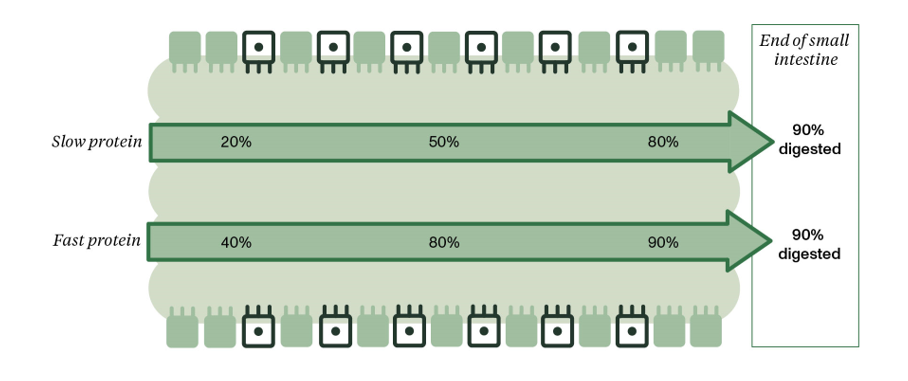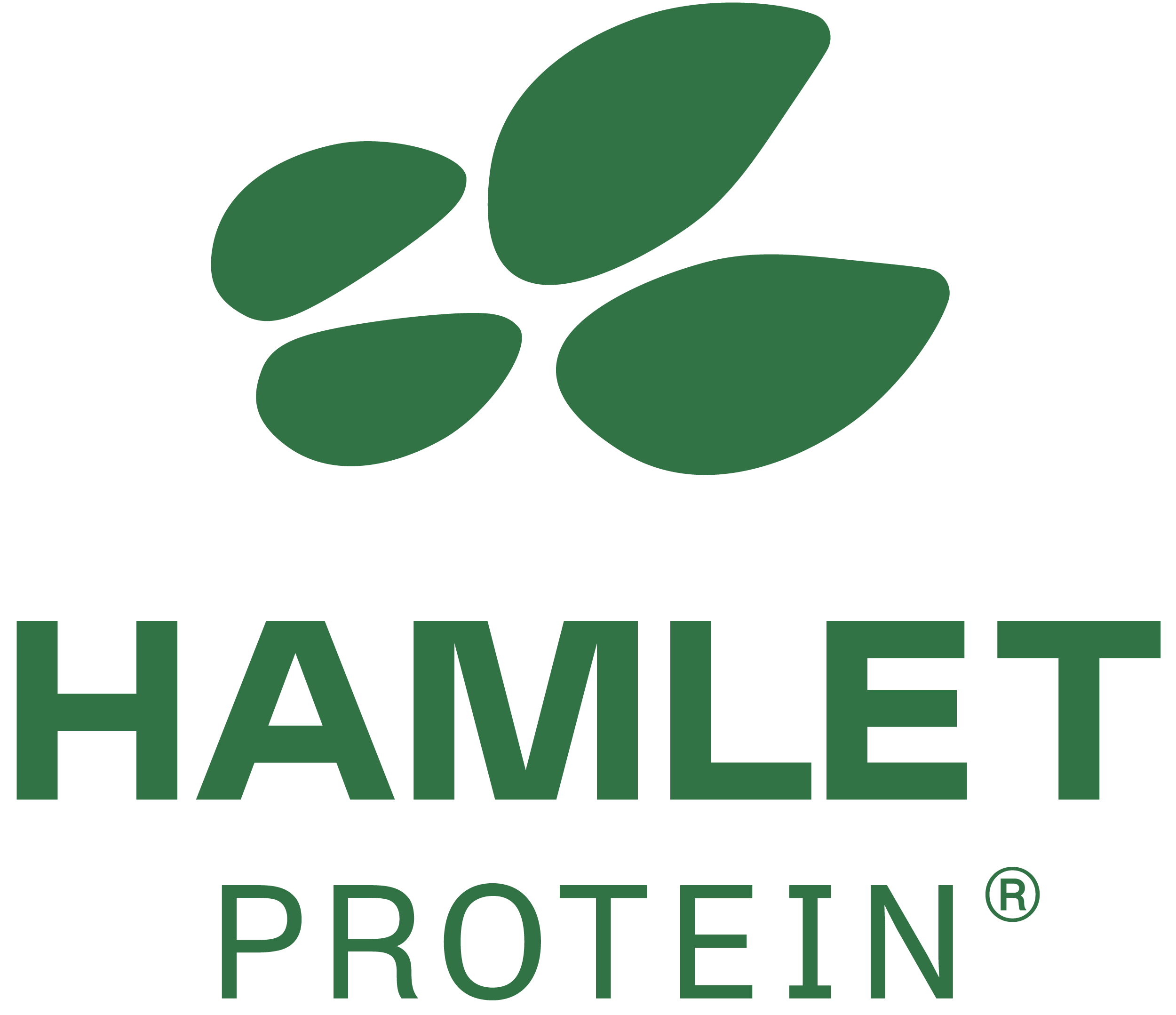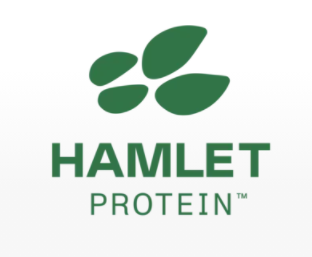



Speed matters: Fast protein sources result in better protein utilization
Protein kinetics is all about the speed of protein digestion.The faster a protein source is digested and absorbed the faster it becomes available for the animals. Research now shows that faster protein ingredients are also better used for growth and performance than slower ingredients which means less protein is wasted. Knowing the protein kinetics of a protein source will allow nutritionists to formulate diets with a higher protein biological value, optimizing animal performance and therefore feed cost, and reducing nitrogen excretion into the environment.
Hamlet Protein has been involved in a large research project to uncover the differences in digestion speed between protein sources. The results of this project are surprising. Some protein sources generally considered as highly digestible and fit for young animals turned out to be extremely slow in their digestion speed. The results of this research have been published recently at the ASAS-CSAS-WSASAS meeting in the USA.¹
What is Protein Kinetics?
The science of digestion kinetics describes the process of hydrolysis and absorption of nutrients in the intestines. Thus, protein kinetics means the dynamics of protein hydrolysis and absorption in the small intestine. In other words, how fast and where in the digestive tract dietary protein is digested, absorbed, and released into the blood stream. The concept is important as both the speed and where in the intestine these processes are taking place matters for the subsequent availability and utilization in the animal.
Traditionally, a protein ingredient is evaluated based upon its protein content (CP) and ileal digestibility coefficient of the amino acids it contains. However, digestibility does not provide the full picture. Protein digestibility only considers how much protein is left at the end of the small intestine. This value does therefore not provide any indications of how fast or where in the intestine the protein is absorbed.
Two protein sources can have similar ileal digestibility coefficients but may differ largely in the speed and site of digestion, and absorption (Figure 1). Consider for instance blood meal and high protein soybean meal (SBM-HP) which both show similar digestibility coefficients at the end of the small intestine (after which is assumed no enzymatic protein digestion occurs anymore). For blood meal, however, a lot more protein is hydrolyzed already in the first part of the small intestine (proximal jejunum) while for SBM-HP more is hydrolyzed in more distal parts of the small intestine. In this study, this means that the protein digestion is faster for blood meal than for SBM-HP. So, protein kinetics is a more accurate description of what happens with the protein inside the animal than digestibility alone.
Protein kinetics considers not only that a protein is digested but also where it is digested, and the resulting amino acids are absorbed.

Why speed matters
Digestion speed is important because the most efficient hydrolyzation and absorption occurs in the jejunum, a part of the small intestine which is closer to the stomach. The reason for this is that glucose is abundantly available as an energy source for the intestinal cells in the jejunum that absorb the amino acids. This means that they can perform optimally and therefore, a greater proportion of amino acids pass into the bloodstream. Consequently, a smaller proportion needs to be oxidized to generate energy. Conversely, less glucose is available further down in the ileum. Therefore, intestinal cells located here will have to use a larger proportion of the amino acids as an energy source, so that the functions of these intestinal cells can continue to be carried out. 2,3,4
Furthermore, insulin growth factor (IGF), which regulates the deposition of amino acids (AA) in tissues, reaches peak levels soon after feed consumption, which favors the deposition of AA during peak levels of IGF. So, the faster a protein is hydrolyzed and absorbed, the more of the protein will be used for protein deposition. Fast absorbable protein ingredients improve nitrogen (N) retention and consequently growth and feed efficiency of the animals.
Recent trial work in weaned pigs at Hamlet Protein showed that despite higher crude protein intake because of higher feed intake in pigs, fed a fast protein diet using HP300 as a protein source, total fecal nitrogen excretion did not differ from pigs on a slow protein (SPC) diet. This indicate that the faster protein digestion speed of HP300 led to a higher feed intake and as a result a higher average daily CP intake. The similar fecal nitrogen excretion indicates a better overall protein utilization for HP300 which was confirmed by significant higher ADG and BW for pigs on HP300.
So, from fast protein less nitrogen is wasted. Therefore, protein kinetics are more indicative of feed efficiency and protein deposition than the digestibility coefficient of the protein ingredient.
Why are fast proteins beneficial? 1. Faster protein hydrolysis early in the small intestine: Peptides are hydrolyzed throughout the small intestine by proteases, and fast protein hydrolysis means that more peptides are hydrolyzed into amino acids in the first part of the small intestine. 2. Faster amino acid absorption into the blood stream: The earlier in the small intestine the amino acids are absorbed, the better synchronization with energy released from starch digestion. 3. Increased protein availability for tissues, milk, and organs: The better synchronization in absorption speed for all amino acid sources, the more of the protein is used for growth and building of tissues, milk, and organs. 4. Improved protein utilization and feed efficiency: Fast absorbable proteins contribute to a better utilization of feed resulting in improved feed conversion ratio and less excretion of nitrogen with urine. |
Formulating diets considering protein kinetics
Young animals have a very high protein requirement but underdeveloped digestive capacity.
They need a lot of protein to further develop their organs, while not fully equipped to extract all the required amino acids from the protein in the diet. In the current practice of feed formulation, digestible amino acids, and net or metabolizable energy contents are used as fixed values of feed ingredients to optimize diets. This is quite convenient but limited as it ignores the variation in nutrient kinetics of different ingredients and does not account for interactions happening between ingredients before and after absorption.
Hamlet Protein collaborated with Aarhus University to test the kinetics of a variety of protein sources as the best way to determine protein kinetics is by mimicking digestion in vitro. Results of these studies revealed that from all vegetal protein sources, Hamlet Protein products show the fastest protein hydrolysis in vitro and even outperforms animal protein like fish meal and blood plasma (Figure 2).

These results have consequences for diet formulation. First, young animals have a high requirement for fast protein. Secondly, when looking to replace a protein source like for instance blood plasma, it is important to replace it with an equally fast protein source in order not to change the total protein kinetics of the diet.
The unique production process of Hamlet Protein using enzymatic treatment does not only effectively reduce the content of anti-nutritional factors, but it also modifies the protein in such a way that it becomes easier accessible for proteolytic enzymes, resulting in a very fast protein source. By including Hamlet Protein in feed formulation, the speed of the feed’s overall protein hydrolysis can be increased, which improves utilization of the feed. This makes Hamlet Protein an advantageous protein source for you and your pigs.
| References | ||||
|---|---|---|---|---|
| Bible, et al. | ||||
| (2023) | In-vitro evaluation of protein kinetics of soy-based ingredients. | Proceedings ASAS CSAS WASAS. | ||
| van den Borne, J.J.G.C.; Schrama, J.W.; Heetkamp, M.J.W.; et al. | ||||
| (2007) | Synchronising the availability of amino acids and glucose increases protein retention in pigs.. Animal | Animal 1:666-674. | ||
| Liu, S.Y.; Selle, | ||||
| (2017) | Starch and protein digestive dynamics in low-protein diets supplemented with crystalline amino acids.. Anim. Prod. Sci., | 57, pp. 2250-2256. | ||
| He, W.; & Wu, G. | ||||
| (2022) | Oxidation of amino acids, glucose, and fatty acids as metabolic fuels in enterocytes of developing pigs.. Amino acids. | 54(7), 1025–1039. |








